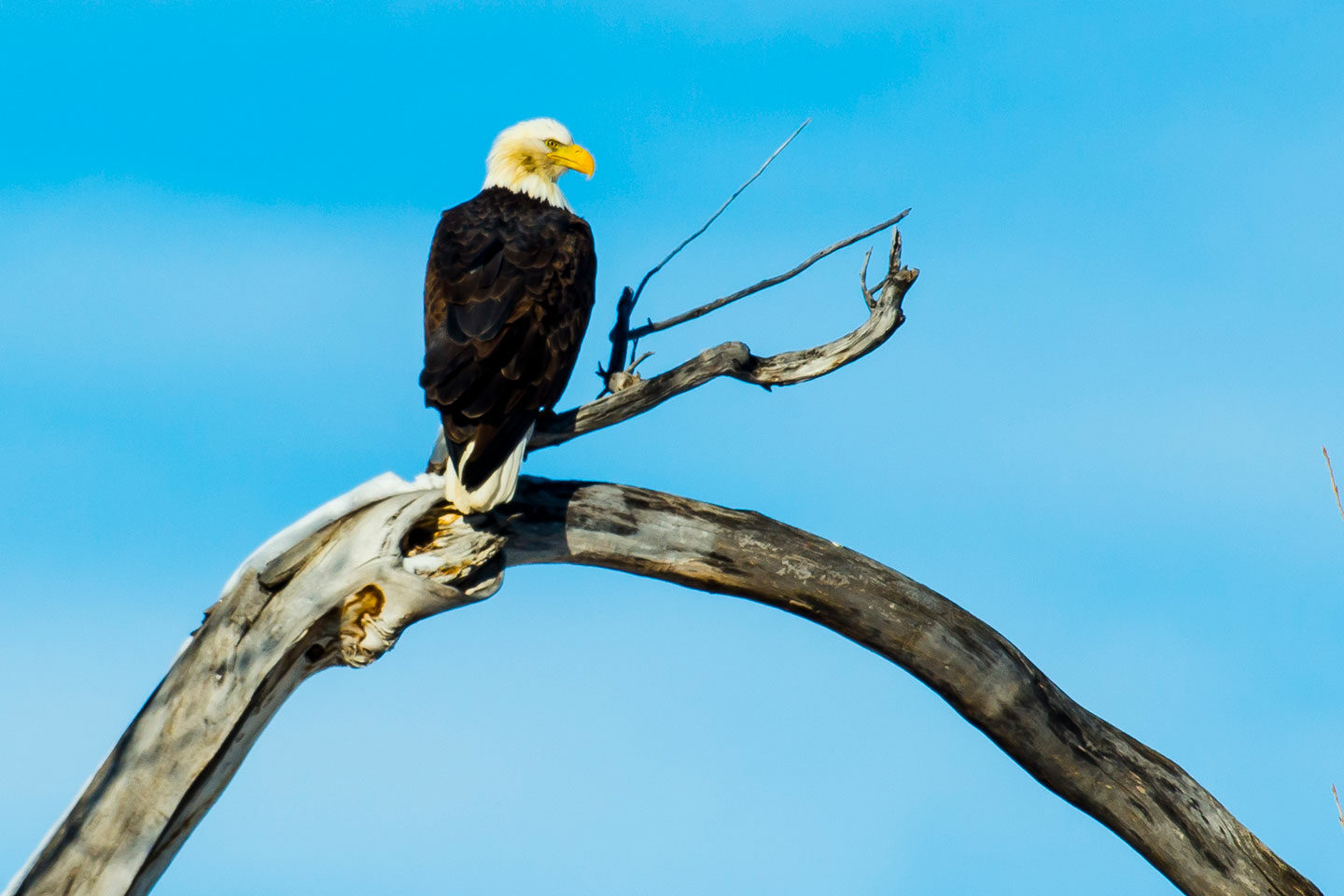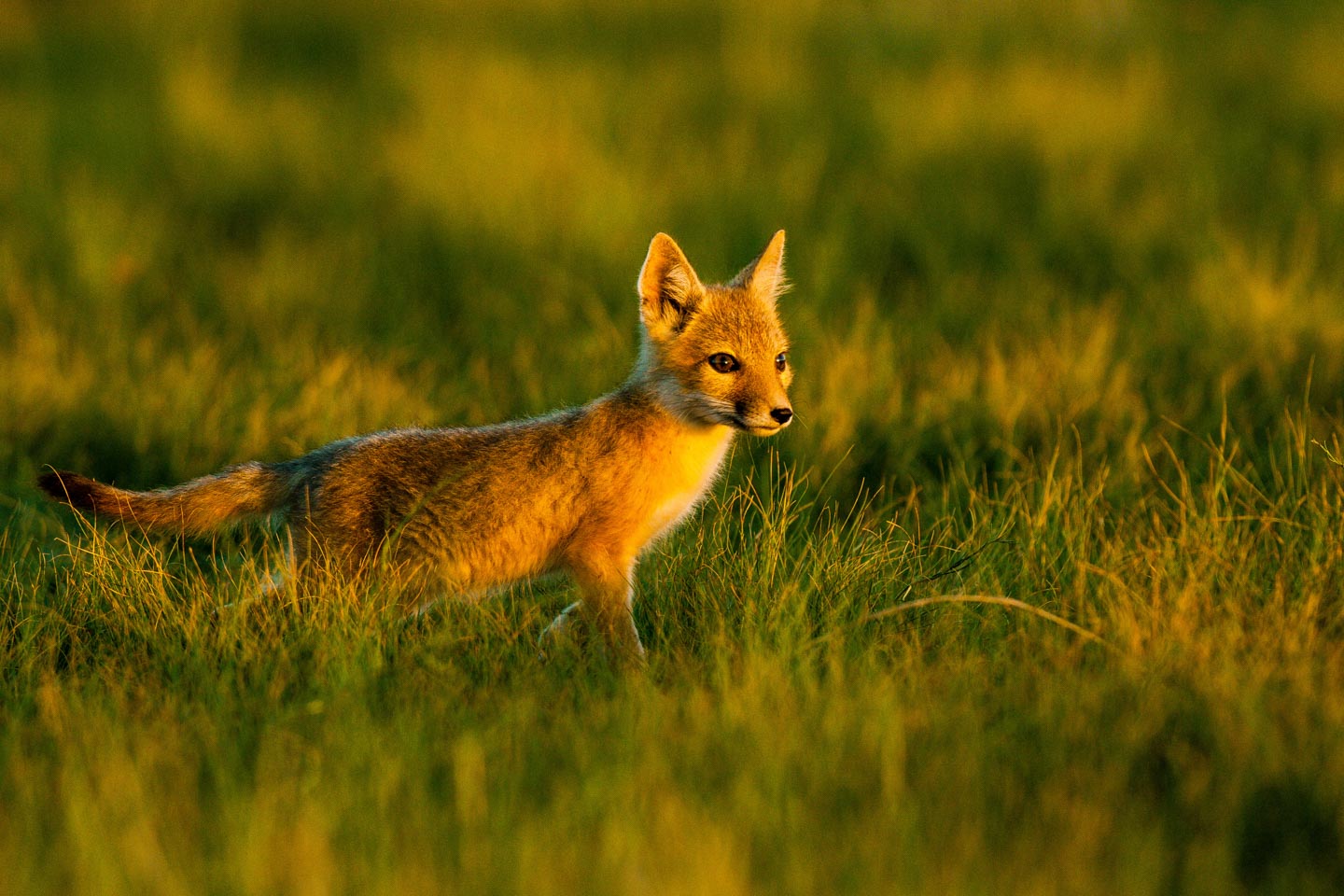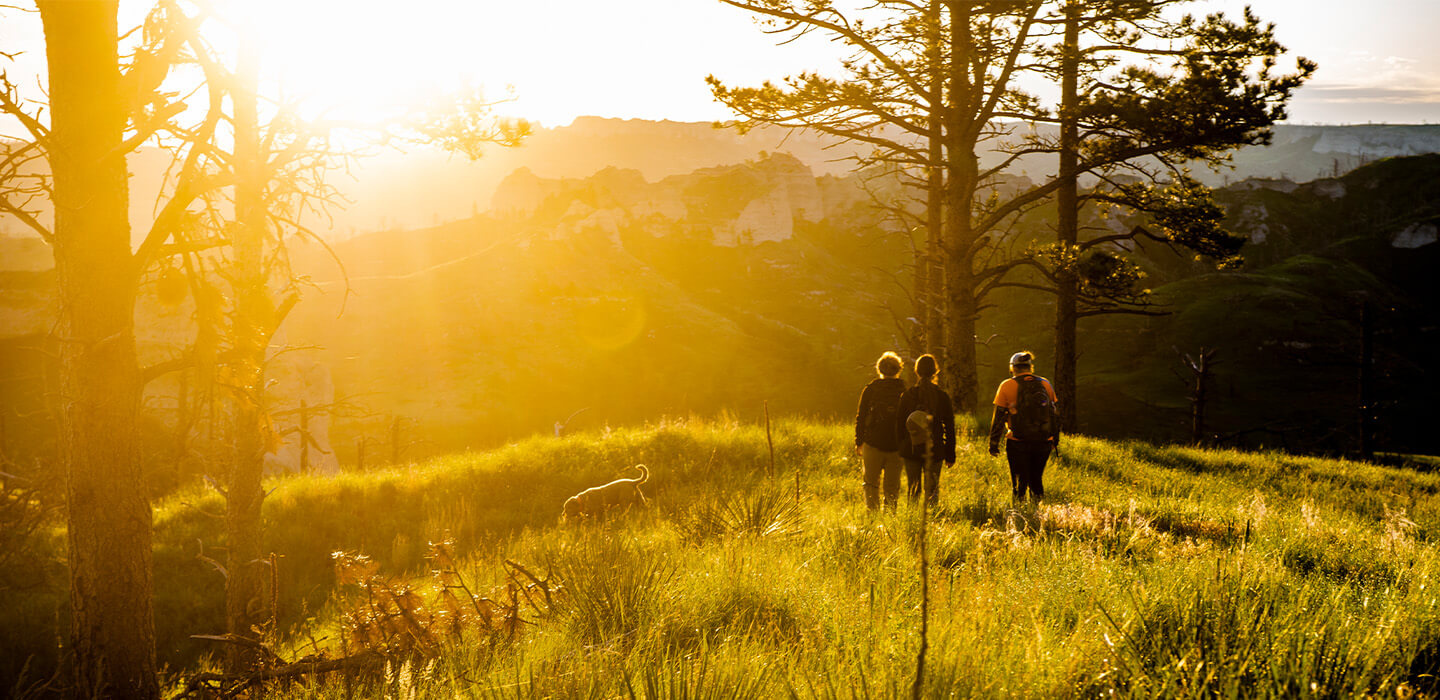Butterflies & Moths
Approximately 206 butterfly species can be found in Nebraska. They are readily seen during warm summer days with little wind. Typically, May to August are the best months for viewing, and you will do well looking in sunny exposed places with low plants. They are typically seen in greater abundance mid-morning to late afternoon and can be found in butterfly gardens, wetlands, woodlands, grasslands and even your backyard.
Butterfly identification
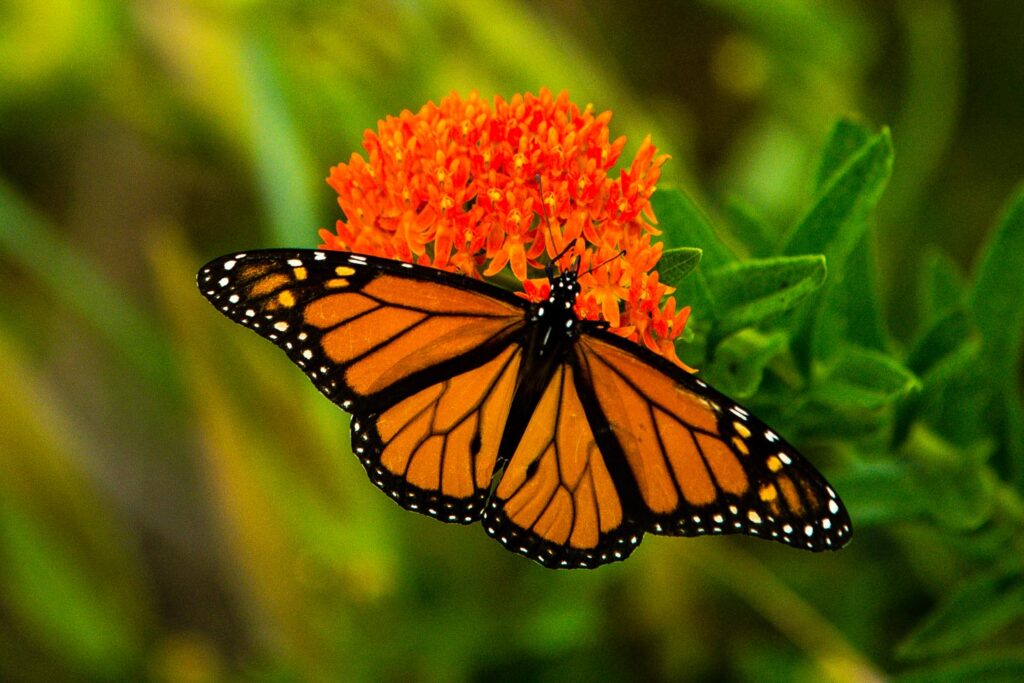
The monarch butterfly is a well-known species. The upper side of the male is bright orange with wide black borders and black veins. The upper side of the female is orange-brown with wide black borders and black veins. The monarch is found in a variety of habitats including fields, meadows, weedy areas, marshes, and roadsides.
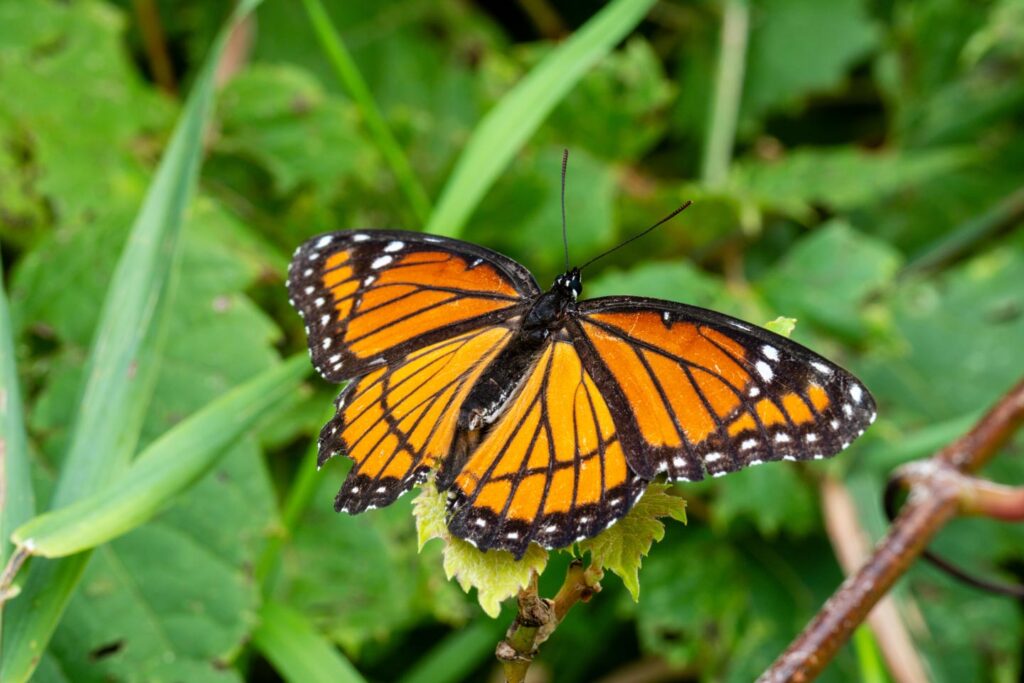
The viceroy butterfly is a mimic. The coloring and pattern of the monarch and viceroy wings are nearly identical. However the viceroy butterfly is smaller than the monarch. The viceroy butterfly benefits from the monarch’s bad reputation, but some viceroys are bad-tasting as well.
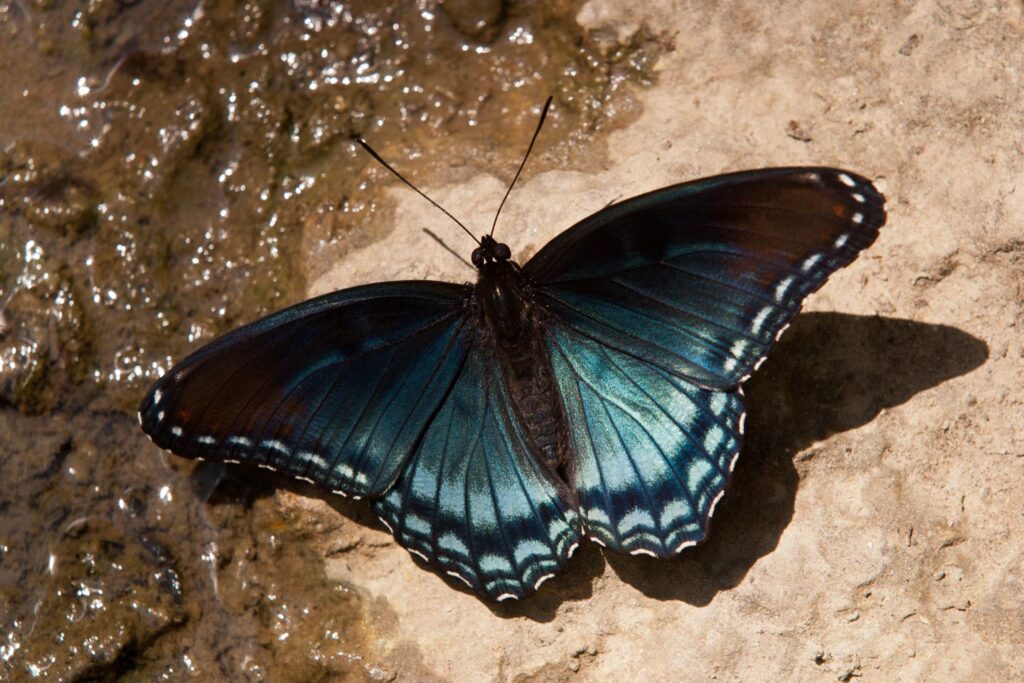
The red-spotted purple butterfly is black with blue or blue-screen scaling. Its upper side is blue to blue-green with much iridescence on the outer part of the hindwing while the underside is dark brown. It features orange or red marks on the tips of the wings.
The Common Buckeye butterfly is brown above. The forewing features two orange bars and two large black eyespots outlined in orange. The hindwing has two eyespots, with the upper one being the largest and containing a magenta crescent. Buckeyes prefer open, sunny locations in fields and clearings. They are nervous, and alert, and fly quickly when nearby movement is detected.
The Checkered White butterfly features white wings populated with dark grayish-blue spots, and its body tends to have a bluish coloration. The wing spread of adults is 1.25 to 2.00 inches. Males are white with charcoal markings on the front wings. Females are grayish-white with darker gray or charcoal checkered markings on both front and hind wings. Early spring and late fall (cool season) adults tend to be smaller, darker, and more heavily patterned.
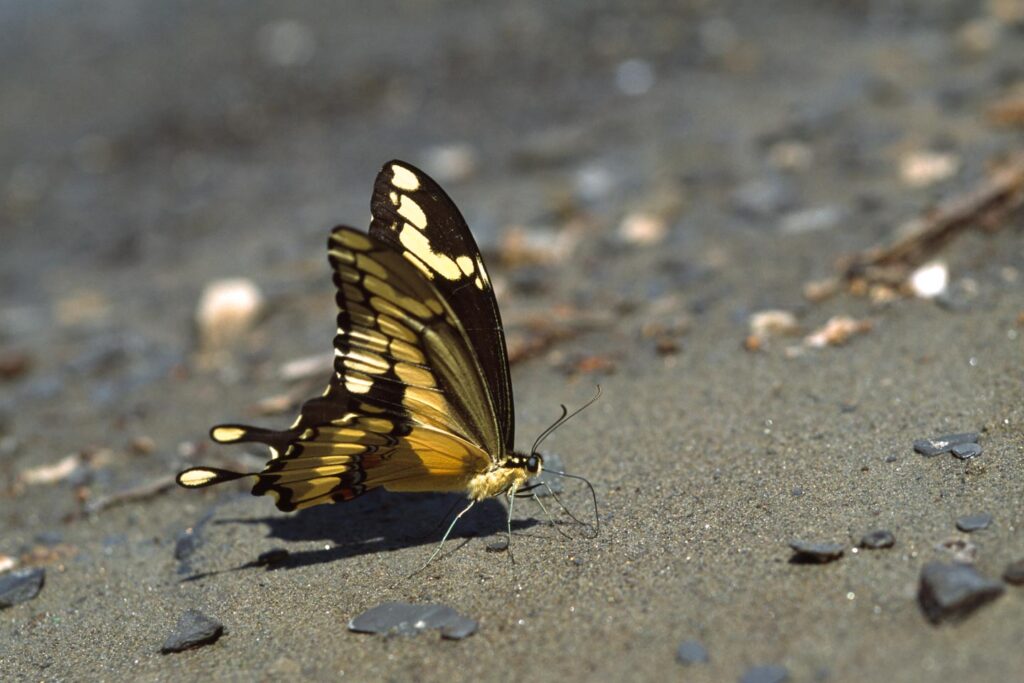
The giant swallowtail is the largest butterfly in North America. It is abundant through many parts of North America. One of the giant swallowtail’s most notable features is its size. Females have an average wingspan of 5.5 in (14 cm), and up to 6.9 in (18 cm), while males’ average is 5.8 in (15 cm), and up to 7.4 in (19 cm).
The wings are black with a horizontal yellow line across the forewings, and a diagonal yellow line across the hindwing. The underside of the wings is yellow with accents of black. A small patch of red on the ventral wing (within the small blue band) allows for distinction from the similar-looking Schaus’ swallowtail.
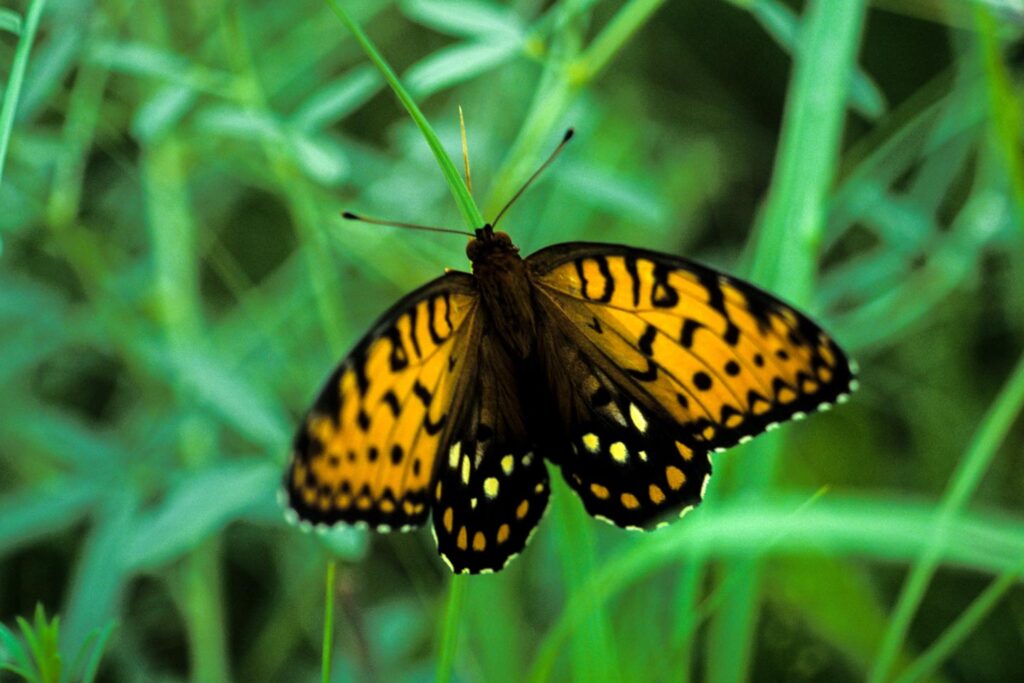
The regal fritillary is a large butterfly that is smaller in size to the monarch butterfly. The upper side of the forewing is bright red-orange with black markings. The upper side of the hindwing is black with a row of white spots and on the wing edge is a row of spots that are orange in males and white in females. The underside of the forewing is orange with a band of white spots and a black fringe. The hindwing is dark greenish brown with white spots.
The regal fritillary is a Great Plains species associated with tallgrass prairies, meadows and pastures. The larvae feed on violets. The adults feed on a variety of flowers such as milkweeds, thistles, clover and purple coneflower. It can be found statewide in Nebraska, but is primarily in the eastern half of the state.
Butterfly survey
There is an urgent need to track regal fritillaries across their range over time to better understand and adjust conservation measures to be most effective. Thanks to the Wildlife Conservation Fund, a community science project was launched last year to monitor regal fritillaries, as well as monarchs, which are similar in appearance.
The wingspan of the great spangled fritillary is 2.5 to 4 inches. It has scalloped orange forewings and hindwings. Females are a darker orange than males. They have black spots on the upperside of their wings and silver spots on the underside.
The adult is a medium sized (1-3/4 to 2-1/4 inch wingspan) yellow-brown butterfly with white spots near the fore wing tips and a band of dark spots and two dark lines following along the wing margin. Caterpillars grow to 1-1/4 inches long, are green, tapered at both ends, and marked with a pair of yellow lines along the top of the body and V-shaped markings on the sides. The head bears a pair of branched knobs and the end of the body has two projections or “tails.”
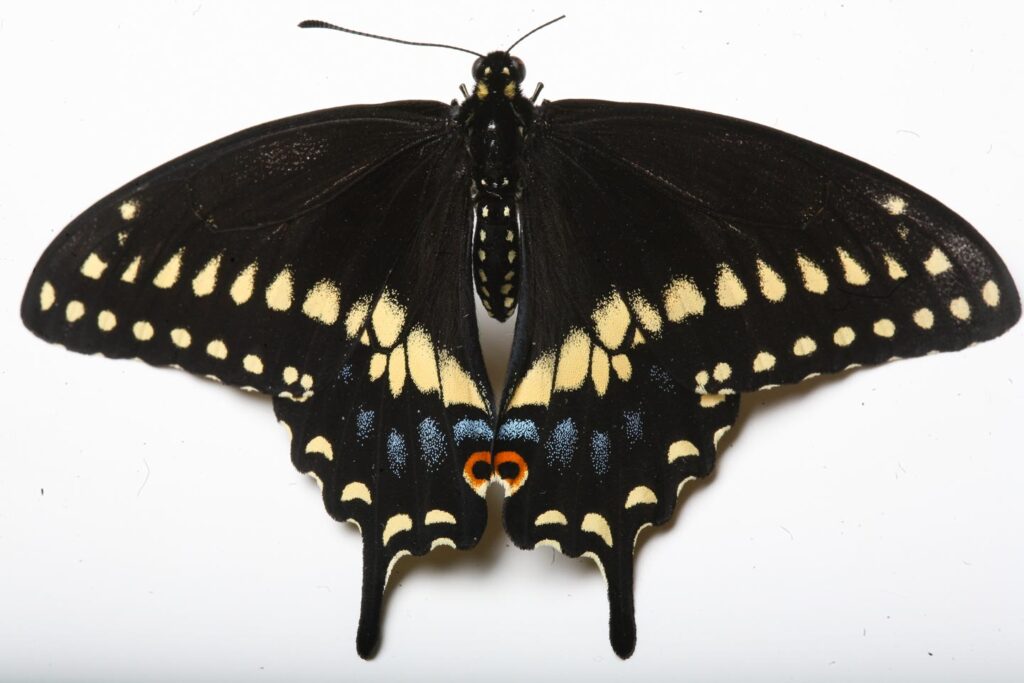
The eastern black swallowtail is one of the most common and most studied swallowtails. Although it is admired for its beauty, it is one of the very few butterflies that may occasionally be considered a pest.
The upper surface of the wings is black with two rows of yellow spots—large and bright in males and smaller and lighter in females. The area between the rows of spots on the hind wings of females is powdery iridescent blue. The blue area in males is much less prominent. There is a conspicuous red spot with a black bulls-eye on the inner hind margin of the hind wings and an isolated yellow spot on the costa of the front wings. The under sides of wings of males and females are virtually identical. The front wings have two rows of pale yellow spots. Hind wings have rows of bright orange spots separated by areas of powdery blue.
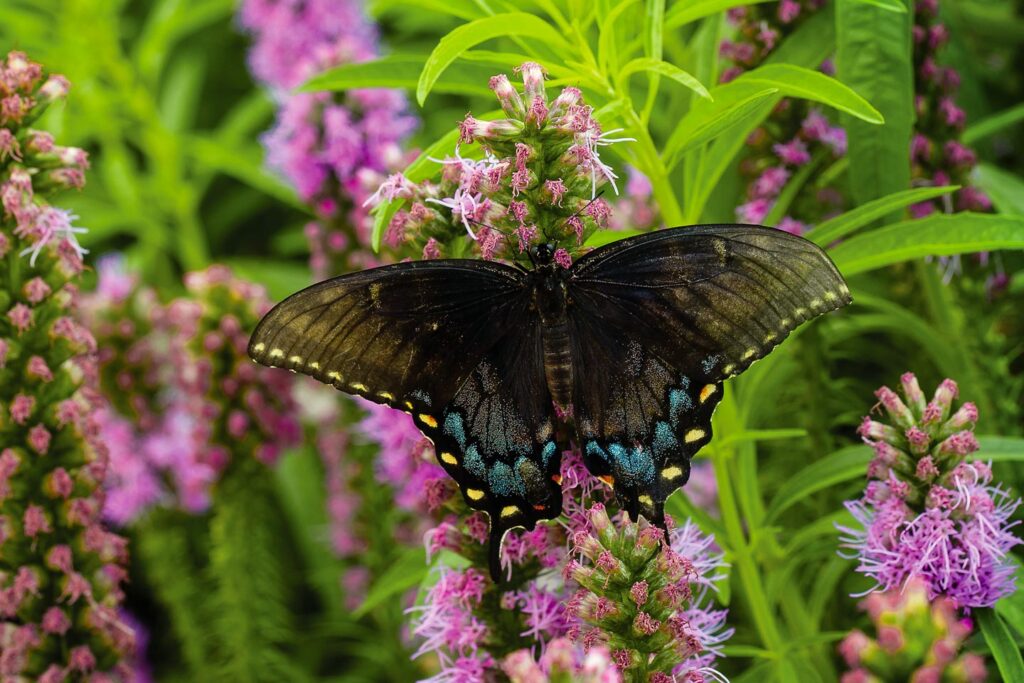


The Eastern Tiger Swallowtail is one of the most recognizable butterflies in Nebraska. It is large in size with a bright yellow color and black “tiger” stripes. Male tiger swallowtails have a few orange and blue spots near the tail. Females have both a light and dark form. The light form looks a bit like the male with the exception of more blue on the hind wings. The dark form still has the blue spots, but it is otherwise very dark with no yellow.
The eastern tiger swallowtail can be found in a variety of habitats, especially near water, but also in meadows, gardens, parks and roadsides. They drink nectar from flowers including milkweed, thistles, honeysuckle, ironweed and red clover.
The mourning cloak is a large butterfly. It is easy to identify with very dark brownish-maroon with pale, cream-colored edges, which often look ragged. They have bright blue spots along the edges and black-brown underwings. This butterfly camouflages itself when it rests on a tree trunk with its wings folded back. Mourning cloaks can be found in open woods, parks, gardens, and along the edges of streams, lakes and ponds. Adults drink nectar from plants, such as milkweed and red maple, rotting fruit and tree sap.
The upper side of the male common checkered-skipper is blue-gray, while the female is black in color. Both sexes have large white spots which form bands across the middle of both wings. The fringes of the male are checkered but black checks only reach halfway to the edge. The underside is dull white with dark gray bands.
The common checkered-skipper can be found drinking the nectar of white-flowered flowers including asters, red clover, fleabane and many others. They are found in sunny places with low vegetation as well as prairies meadow, fields, roadsides, landfills, yards, gardens, pastures and woodlands.
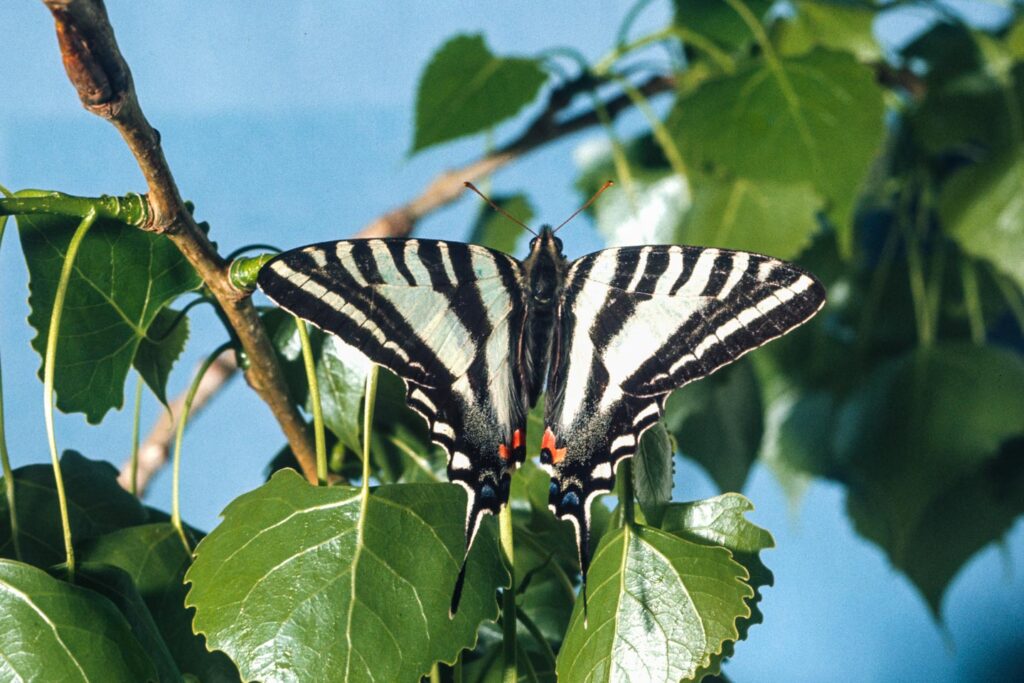
The zebra swallowtail’s upper wing surface has black stripes with a pale white-green background. Its hindwings have very long tails. The early spring form is smaller and lighter colored. These swallowtails breed in moist low woodlands near swamps and rivers. Adults fly to nectar plants in open fields and brushy areas seeking moisture from sand and nectar from flowers including blueberry, blackberry, lilac, redbud, verbena and common milkweed.
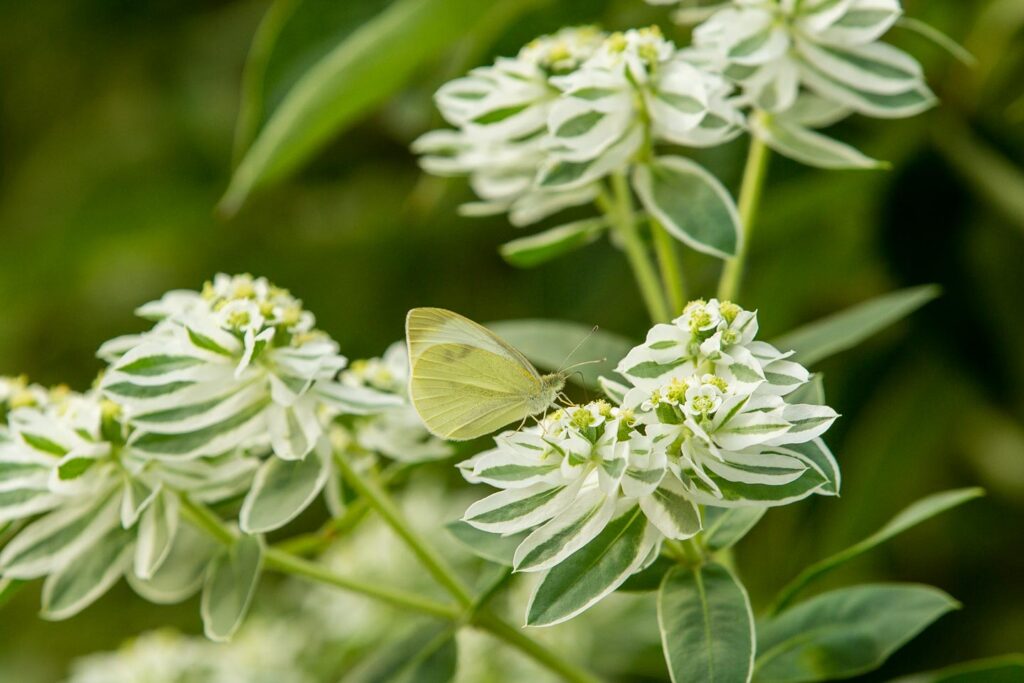
The cabbage white butterfly is recognized easily with its charcoal gray tips. Males have a single black spot on the center of each forewing while females have two spots in the same place. The color under the forewings may be yellow or light green and is visible when the wings are closed.
The cabbage white butterfly can be found from early spring to late fall. They are well adapted to urban areas but can also be found in fields, meadows, parks and gardens. The caterpillar can be found feeding on the leaves of cabbage and other cruciferous vegetables such as broccoli and cauliflower.
The cabbage white butterfly is not a native Nebraska species and was introduced from Europe during the 19th century. It has since spread across the country.
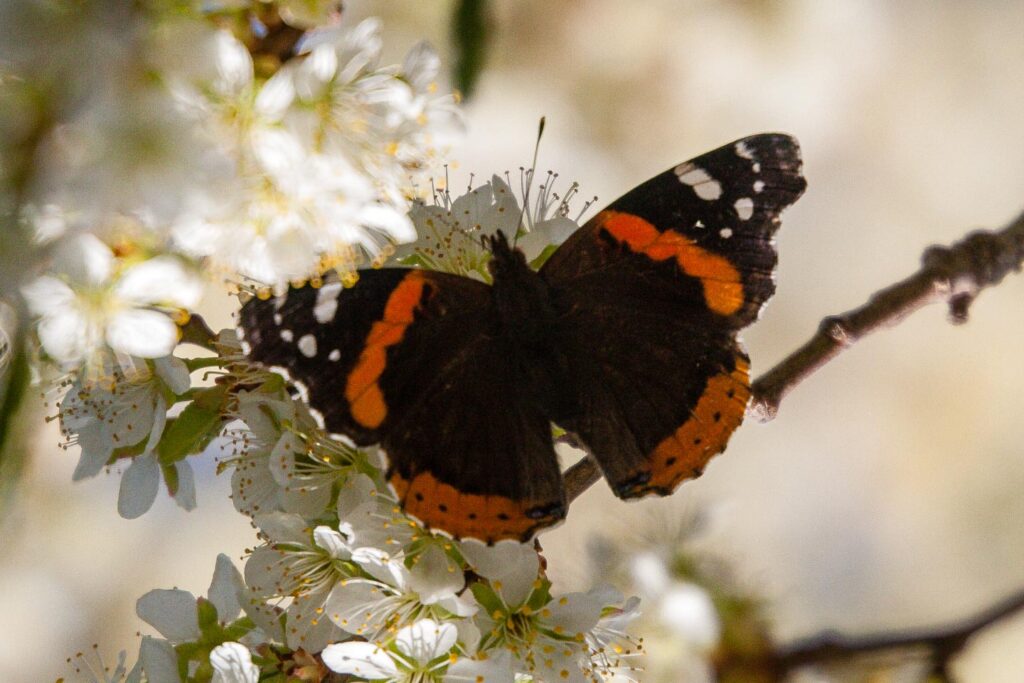
The red admiral or previously, the red admirable, is a well-characterized, medium-sized butterfly with black wings, orange bands, and white spots. It has a wingspan of about 2 inches (5 cm).
Red admirals are territorial; females will only mate with males that hold territory. Males with superior flight abilities are more likely to successfully court females. It is known as an unusually people-friendly butterfly, often landing on and using humans as perches.
The gray hairstreak is the most common hairstreak butterfly. Look for the tails, the plain gray underwings with the narrow, tri-colored band of orange, black and white crossing both wings and the orange eyespot with a black center on the rear edge of the hindwing. Gray hairstreaks use a large variety of host and nectar plants that are commonly found in disturbed environments where humans are active. This is a wonderful visitor to observe among your landscape plantings including milkweed, dogbane, goldenrod and queen-Anne’s lace.
The question mark butterfly has upper hindwings that are mostly orange. The summer generation has mostly dark upper hindwings. They are identified by the silvery “squiggle plus a dot” in the center of the under hindwing. This butterfly overwinters in Nebraska and can be seen flying on warm winter days. It rarely visits flowers but is attracted to carrion, scat, over-ripe fruit and puddles on damp earth.
Moth identification
While not as charismatic or well-studied as butterflies, moths are still important components of the ecosystem. They can be just as colorful and diverse as well. The video below highlights the various species of moths one might discover in Nebraska.
Additional resources
More information about butterflies can be found at the following links:
Butterflies of Nebraska
Butterflies and moths of North America
Butterfly gardening
Butterflies in NE: Nebraska Lepidoptera -A Comprehensive Guide to Nebraska’s Butterflies

